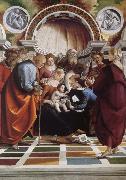
Oil On
Canvas, Real Flavor of Old Masters
|
Tintoretto
|
|||
|
|
|||
| Italian Mannerist Painter, ca.1518-1594 His father was a silk dyer (tintore); hence the nickname Tintoretto ("Little Dyer"). His early influences include Michelangelo and Titian. In Christ and the Adulteress (c. 1545) figures are set in vast spaces in fanciful perspectives, in distinctly Mannerist style. In 1548 he became the centre of attention of artists and literary men in Venice with his St. Mark Freeing the Slave, so rich in structural elements of post-Michelangelo Roman art that it is surprising to learn that he had never visited Rome. By 1555 he was a famous and sought-after painter, with a style marked by quickness of execution, great vivacity of colour, a predilection for variegated perspective, and a dynamic conception of space. In his most important undertaking, the decoration of Venice's Scuola Grande di San Rocco (1564 C 88), he exhibited his passionate style and profound religious faith. His technique and vision were wholly personal and constantly evolving. | |||
|
|
|||
|
|
The Circumcision new9/Tintoretto-329476.jpg Painting ID:: 32700 Visit European Gallery |
c. 1587 Oil on canvas, 440 x 482 cm | |
Height Width |
INS/CM |
||
|
X |
|
||
|
|
|||
|
Luca Signorelli
|
|||
|
|
|||
| Crtona 1441-1523 .Italian painter of the Umbrian school, who probably studied with Piero della Francesca. He worked in Cortona, where some of his paintings have remained. Subsequently he worked in the Cathedral of Perugia, in Volterra, and at Monte Oliveto before undertaking (1499) the decoration of the Cappella Nuova in the Orvieto Cathedral. There he represented the apocalyptic series of the Story of the Anti-Christ, the End of the World, the Resurrection of the Bodies, Paradise, and the Inferno, as well as figurations from antique poems and the Divine Comedy. The infernal scenes are remarkable for their imaginative evocation of fiends and tortures of Hell. Michelangelo was influenced by his powerful treatment of anatomy and the vivid realism he used for dramatic ends. Signorelli's paintings in the Vatican, where he went in 1508, were later sacrificed to make way for some of Raphael's work. | |||
|
|
|||
|
|
The Circumcision new16/Luca Signorelli-954478.jpg Painting ID:: 42874 Visit European Gallery |
mk170 circa 1490-1495 Oil on wood 258.5x180cm | |
Height Width |
INS/CM |
||
|
X |
|
||
|
|
|||
|
Marco Marziale
|
|||
|
|
|||
| Italian Painter, active ca.1492-1507,Italian painter. He was first recorded in 1492 as one of several assistants to Giovanni Bellini in the Doge's Palace in Venice; in an inscription on his earliest known work, a damaged Virgin and Child with Saints and a Donor (1495; Zadar, St Mary, Treasury), he called himself a pupil of Gentile Bellini. Visual confirmation of his close association with both Bellini brothers is provided by the rather large number of his signed and dated works, many of which are closely based on compositional motifs by Giovanni, but which in their linearity and angularity more closely resemble the style of Gentile. The influence of German art, and of Derer in particular, has often been noted in the sharply focused and densely packed details, the harsh modelling and the expressive ugliness found in much of Marziale's work. | |||
|
|
|||
|
|
The Circumcision new16/Marco Marziale-884882.jpg Painting ID:: 42983 Visit European Gallery |
mk170 date 1500 Oil on canvas 222.3x151.1cm | |
Height Width |
INS/CM |
||
|
X |
|
||
|
|
|||
|
Domenico Tintoretto
|
|||
|
|
|||
| Italian, 1560-1635,Son of Jacopo Tintoretto. He was taught by his father and assisted him in his workshop. At the age of 17 he was admitted to the Venetian painters' guild, and he is recorded in the confraternity of painters from 1594. He began his career by helping his father to execute the paintings in the Sala del Collegio and Sala del Senato in the Doge's Palace, Venice. Following this he worked independently at the palace, on the Sala dello Scrutinio and the Sala del Maggiore Consiglio. His training with his father helped him in his own compositions, several of which, such as the Battle of Salvore, or the Second Conquest of Constantinople, are heroic battle themes with complex groupings and dramatic poses. In the last two decades of the 16th century Domenico concentrated on religious commissions in Venice, including a Last Supper and Crucifixion (both c. 1583) for S Andrea della Zirada (both in situ), a Marriage of the Virgin for S Giorgio Maggiore (in situ) and a Crucifixion for the Scuola dei Mercanti. | |||
|
|
|||
|
|
The Circumcision new24/Domenico Tintoretto-386474.jpg Painting ID:: 73963 Visit European Gallery |
1587(1587) Oil on canvas 440 X 482 cm cjr | |
Height Width |
INS/CM |
||
|
X |
|
||
|
|
|||










